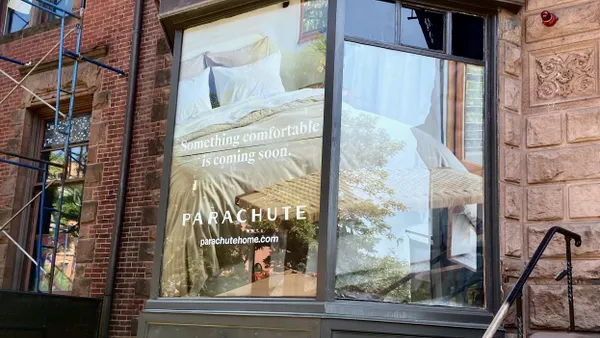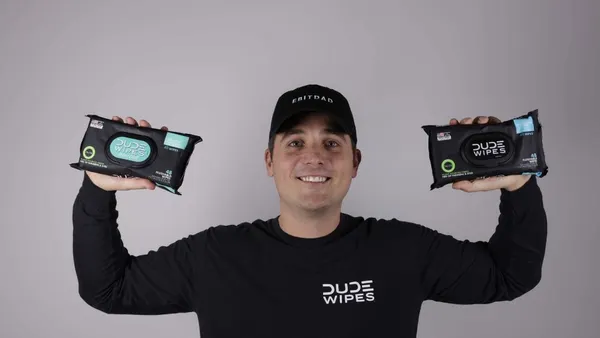This week marks the third year Montreal-based Addition Elle is showing off its plus-size clothing lines at New York Fashion Week, and its debut at the official venue.
For the first time, plus-size brands made their entrance at the official New York Fashion Week venue, with Torrid and Addition Elle taking the runway. "It’s like being off Broadway, on Broadway," Roslyn Griner, Addition Elle VP of Marketing, described to Retail Dive from the brand’s one-week pop-up shop in New York City’s Flatiron District. "You feel like part of fashion elite," she said. "I think it gives us a certain credibility and authenticity that we are truly part of fashion week."
The Canadian brand’s presence at the biggest American fashion event of the year is no accident. It's timed with the release of see now, buy now collections that began selling this week, and it's also a way to support the recent soft launch of a U.S. website. The guide shop serves as a way to spread awareness about the brand and its fit to American consumers. Addition Elle, founded in 1980 and acquired by Reitmans Canada In 2001, is quickly expandinging the U.S., not only online, but also in U.S. department stores Nordstrom, Dillard’s and Macy’s, where it will expand from 50 to 150 stores in the spring.
The plus-size market is rapidly growing in the U.S. as more brands have embraced body positivity movements and expanded sizing — and for good reasons. From a financial standpoint, sales of women’s plus-size clothing rose 6% to $21.4 billion in 2016, according to market researcher NPD Group. By 2020, the group expects revenue in the segment could hit $24 billion.
Retail Dive spoke with Griner about Addition Elle’s effort to reinvent the reputation of plus-size clothing as stylish and fashionable with the help of American influencers, such as Ashley Graham and Jordyn Woods, as well as the opportunity the company sees in the U.S. market. The conversation has been edited for length and clarity.
RETAIL DIVE: As Addition Elle pushes into the U.S. market, what opportunities do you see?
GRINER: The players that have always been big in the U.S. market like Lane Bryant and Torrid, are still the major players, but l feel it's an underserved market when you see the amount of women who are over a size 14 in the U.S. There is still an under penetration of fashion retail [in plus-sizes] than for straight sizing and the same truth is held whether it's Canada or the U.S.
We fill a perfect niche because we're not quite Lane Bryant. We offer a fashion aesthetic and have a more balanced portfolio — career and casual — than Torrid, which is casual. We have a European flair even though we're North American.
We’ve been eyeing the U.S. market, we've watched as American competitors have come into our market like Torrid, they now have 15 stores in Canada. So we said, 'Why are we letting people play in our market and not going into their market?' We obviously felt that this is the closest market for us to enter. It's also [that] our repositioning and our merchandising is ready in terms of consistency to really go after that customer.
And it was also about engaging with the fan base we already had following us on social media. We have 230,000 fans on Instagram and 65% of them are American, so there was already a built-in pent-up demand for the brand here in the U.S. What's interesting for us is that we’re attracting a younger demographic, maybe just because the pop-up is in New York City in the Flatiron district.
What are the challenges of getting into the U.S. market?
GRINER: The lack of awareness is number one. We have a big social following, but it's a drop in the bucket of a huge market 10 times the size of Canada. Increasing our brand awareness, which is another reason why I signed on influencers who had very strong awareness in the United States, like Ashley Graham. When I first signed her she wasn’t that well known, but now she's a major star in this market.
By associating ourselves with Ashley Graham, we are able to ride her coattails, to have her increase the awareness of Addition Elle. For example, she's coming to our pop-up shop to do a meet and greet. That has a huge influence when she posts on her own social platform to her 5 million followers.
Recently after you joined Addition Elle, the company launched an effort to revitalize the brand. Why? And how were you aiming to reposition the brand?
GRINER: Six years ago when I started out, we were repositioning the brand and we established our premise was to deliver fashion democracy where style wasn't limited by size.
We also decided to become a house of brands, because women knew Addition Elle very well and they knew it stood for a plus-size store. [But] there was always this hesitancy for women to admit they shopped at Addition Elle. So we did some market research and found they were cutting out the labels of our clothing because they didn't think it was cool, they didn't want their friends to know they were shopping there. There's all kinds of psychology behind that.
I remember going into the stores themselves and being very depressed to see the experience of plus-sized fashion. It was dark and it wasn't fashionable, and it was an assumption that plus-sized women were old women. It really didn't appeal. I thought, 'If I was my age and I wanted to walk into the store would I buy anything?' And I thought, 'No.' And they weren't really being portrayed in the magazines and the press in a very desirable, fashionable way and I really felt like, what if I could bring that Zara editorial feeling to the brand? Of course, the product has to follow suit. First came the positioning, and then really working with the merchants and designers to deliver on that brand positioning.
Why Jordyn Woods? Well, Jordyn Woods is making it cool for a girl who is 20 and under to go into the store and see there is fashion for her. And because [Jordyn] is here, it makes sense. It was very much intentional, why we approached Jordyn, because we wanted to talk to that millennial customer. You may need to shop in a plus-sized store, but you want to make sure it sells fashionable and cool and relevant, and she’s so much a part of that experience. People follow her, they love her, she has 4 million followers, it's crazy.
Have sales increased as the brand's identity is revitalized?
GRINER: I can’t speak to the numbers. We're a public company and we don't report on individual banners, we report on the whole. But as we closed doors because digital and our e-commerce business now represents 20% of our total sales, we have seen a big shift toward double-digit growth of e-commerce. As we close stores, our overall sales have increased, which is telling us that we're performing better on a comp basis.
The younger demographic and particularly in the plus world, because they've never been given good options for brick and mortar, they've always shopped on e-commerce. There's so much more selection and breadth of product on the digital pure plays than there is in brick and mortar. So if you really wanted to have a fashion experience, you wanted to go more toward digital, and I think that remains the case. When I speak to mainstream retailers like Macy’s or Nordstrom, e-commerce is a big proportion of their sales.
Do you think sentiment about plus-size retail is changing, and to what extent have influencers played in that?
GRINER: I'm not going to say it's changed 100%, but Addition Elle is a cool brand that is now followed by 230,000 fans. We had no Instagram following six years ago. I do think influencers like Ashley Graham and Jordyn Woods partnering with us changed and shifted the sentiment behind the brand, and the reaction we got at NYFW is supporting that. So yes, the sentiment about our brand is improving and in the U.S. market we have the opportunity to start from scratch — we have no baggage.
I think sentiment about the plus-size market has really improved. You see mainstream brands extending brands to plus, like Rachel Roy or Rebel Wilson. I do think we’re starting to see it, but not enough. I would still say there’s a lot of designer brands that won't do extended sizing. They’ll used a curved model in their show, but if you really look at their lineup, they go up to a size 12. So they're really not addressing that demographic.
How have marketing efforts changed as the brand has evolved?
GRINER: It’s become a shift to more digital and mobile. We see our customer converting more onto social and digital platforms, we have a lot of earned media coming from our social signals. Today we are promoting a lot more on digital, so I see a shift in my marketing budget going more to digital than traditional. There is still traditional media because I think the two amplify each other. We are still on TV in Canada, but we have invested and shifted our media spending to digital.
We are doing geolocation targeting, content marketing with Buzzfeed and Vice — really different platforms that we would never have done in the past. I think the first campaign we did last year, the F*This campaign, was quite shocking. People thought we said the bad word, but we didn't. It was about fashion. It gave you the impression though.
We've always been a brand that's kind of pushing the envelope and doing things outside of the traditional. We’re not that all-American or Canadian brand. We're really pushing the envelope in terms of the sexiness, confidence factor, the editorial look and feel of our makeup and our styling











